Glossary
of common SVT terms
Knowing the lingo of supraventricular tachycardia (SVT), may help you when you have heart-to-heart conversations. Below, you’ll find definitions for words you may commonly hear about SVT.
Anti-arrhythmic drugs (AADs)
Medications that act by slowing down the electrical conduction in the heart
Atrioventricular (AV) node
A bundle of cells that coordinates the beating of the heart by controlling how the heart’s electrical signals travel from the upper to lower chambers of the heart
Atrioventricular nodal reentrant tachycardia (AVNRT)
The most common form of SVT. In AVNRT, the AV node is split into two and electrical impulses travel down one side of the AV node and then back up the other, creating a fast heartbeat over 100 beats per minute
Atrioventricular reentrant tachycardia (AVRT)
The second most common form of SVT. In AVRT, a fast heartbeat is caused by an extra connection that directly connects the upper and lower chambers. Electrical signals during this form of SVT typically travel from the upper and lower chambers then back to the upper chambers over the short circuit, leading to a rapid heartbeat
Beta blockers
Medications typically used to help prevent SVT episodes because they can slow electrical conduction through the AV node
Calcium channel blocker (CCB)
A medication class used to treat many cardiovascular indications, including SVT, by decreasing the amount of work the heart has to do
Cardiac monitoring system (CMS)
A device that records the electrical activity of the heart. Generally, it records heart rate and rhythm but may have additional features
Cardioversion
A procedure in a hospital or clinic where electrodes are placed on the chest and an electrical current is sent to the heart to reset the rhythm back to normal
Catheter ablation
A procedure in which a doctor guides a long flexible tube (or catheter) in your artery or vein to the heart. The catheter delivers extreme heat or cold to destroy the heart tissue that is causing an abnormal rhythm
Electrocardiogram (EKG or ECG)
A recording of the electrical activity of the heart. An EKG/ECG records the signal associated with each heartbeat
Holter monitor
A small, portable device with sticky electrodes, or tabs, that are connected to the chest to continuously record the EKG/ECG over several days
Heart rate (HR)
The number of times the heart beats per minute, which can be affected by many factors. For example, one’s heart rate may get faster when exercising or when excited. The heart rate can get slower when one feels rested and calm, or with certain medications
Paroxysmal supraventricular tachycardia (PSVT)
Your healthcare provider may refer to SVT as PSVT. The two terms mean the same thing. “Paroxysmal” means that an episode begins suddenly and can happen repeatedly.
Sinus rhythm (SR)
The heart’s normal pattern of electrical activity, starting from the top right chamber and then spreading to the other chambers
Sinoatrial (SA) node
The heart’s natural pacemaker
Supraventricular tachycardia (SVT)
Heart condition that leads to episodes of a fast, regular heartbeat that starts and stops without warning. Your healthcare provider may refer to SVT as PSVT, or paroxysmal supraventricular tachycardia. The two terms mean the same thing.
Vagal maneuvers
Simple things an individual can do that may slow heart rate and stop an episode of SVT. Vagal maneuvers are not right for everyone and should only be performed if advised by your doctor

Stay up to date about SVT with education, resources, and support.
By submitting your email, you confirm you are over 18 years of age and consent to receive future emails from SVTHeartToHeart.com and Milestone Pharmaceuticals. View the Terms of Use and Privacy Policy.
References
1. Helton, M.R. Am Fam Physician. 2015;92(9):793-800. 2. Al-Zaiti, S.S. Crit Care Nurs Clin North Am. 2016;28(3):309-316. 3. ACLS Certification Institute. Vagal maneuvers with supraventricular tachycardia. 2023. 4. Colucci, R.A. Am Fam Physician. 2010;82(8):942-952. 5. Mayo Clinic. Beta Blockers. 2023. 6. Fahie, S. Verapamil. StatPearls. 2023. 7. Cleveland Clinic. Cardiac event monitor. 2023. 8. Mayo Clinic. Cardioversion. 2023. 9. Mayo Clinic. Cardiac ablation. 2022. 10. Mayo Clinic. Electrocardiogram (ECG or EKG). 2022. 11. Colucci, R.A. Am Fam Physician. 2010;82(8):942-952. 12. Hafeez, Y. Paroxysmal supraventricular tachycardia. StatPearls. 2023. 13. Page, R. L. Circulation. 2016;133(14):e471-e505. 14. Mayo Clinic. Supraventricular tachycardia. 2022. 15. Bibas, L. CMAJ. 2016;188(17018):E466-E473.
Back to top
